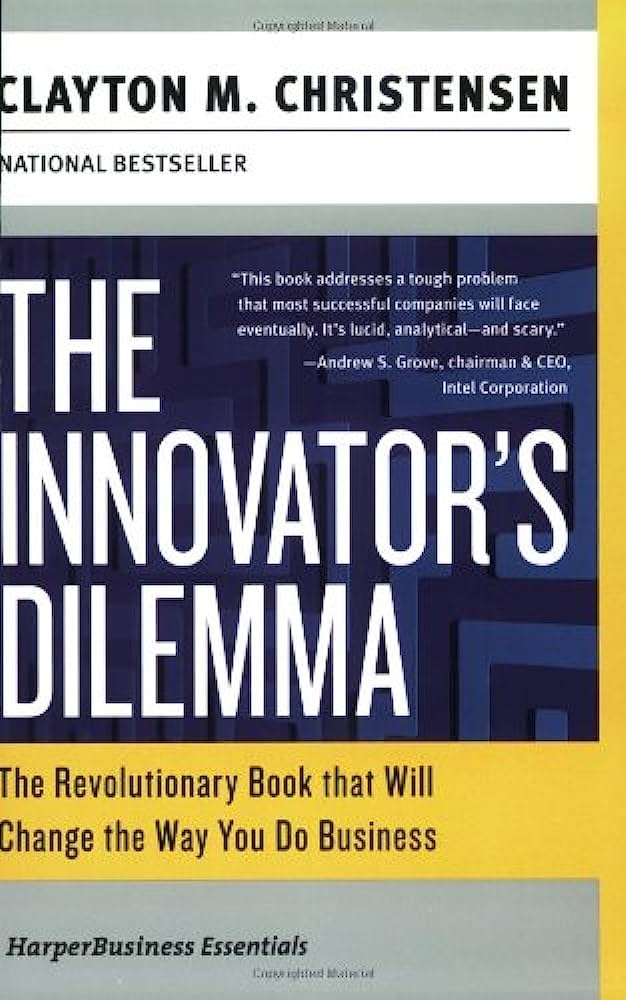The Innovator’s Dilemma: The Revolutionary Book That Will Change the Way You Do Business
RATING


Clayton Christensen analyzes companies that have failed to retain their market leadership in the face of disruptive technologies. These disruptive technologies do not only bring down weak companies; companies that analyze the industry, invest in new products, and carefully track customer needs can fall prey to the pitfalls of new technologies entering the fray. Christensen looks specifically to these companies and how such dominant forces can be upended by the simple introduction of a new product, technology, or company.
When the veneer is washed away, the book becomes an analysis of how disruptive and sustaining technologies affect both large and small companies. The book then transitions towards understanding this phenomenon of companies being overtaken by new technology, establishing four principles that define disruptive technologies. Viewing it from a large company’s perspective, he then goes on to identify how to tackle these principles and mitigate negative impact. Essentially, Christensen focuses on the understanding of the dilemma, citing that it is after recognizing and analyzing the dilemma companies can finally address it productively.
The Innovator’s Dilemma uses examples that span across multiple industries, which we believe makes it clear that the issue is not an isolated concern. Technology and hard drives are fast paced industries and the primary example that Christensen sources, but his referencing to backhoes and steel mills conveys that this issue also occurs in relatively steady industries as well. Christensen’s focus on disruptive technologies is in parallel with how we view disruptive relationships for banks; both offer an opportunity for growth, as well as a pitfall for failure if not capitalized upon. In particular he focuses on pairing disruptive technologies with the proper customers, which is a parallel of Senteo’s view of creating a customer relationship in order to propose the appropriate product package for their needs. Most importantly, the book aims to address a typically unaddressed question: how does innovation hurt companies. Many books will focus on how innovation should be at the core of a business, but Christensen addresses how that can also be a double-edged sword that topples businesses with sustaining technologies.
We believe that Christensen’s book would have benefitted from additional insight made by an expert in the technology to relate how the progression of technology has created the innovative environment that has shaped the speed of growth in the industry. There is the unanswered question, “Will this affect entrenched industries such as consumer discretionary, utilities, or financial services?” Yes, he does reference backhoes which would cover manufacturing and mining, but in a service-oriented industry or other medium of consumer products will sustaining companies face the same sort of issue? Despite using the electric car case study as a hypothetical assessment of disruptive technology, we have not seen a reason to believe that this spans across all industries. Yes, it may not be restricted by the pace of innovation, but it has not proven to be rampant across any and all industries. The book is dated and we have taken that into account, but even the updated version does not address the new environment that we now are facing. Technology has only accelerated in the past decade, and this has resulted in many industries innovating their offerings on a more regular basis, so it is difficult to assess whether companies remain as entrenched against innovation as they were in the past. For that reason, we question how applicable this information is with recent changes in the marketplace. Had this been updated with more recent information or at least covered a crisis period such as the dotcom bubble and post 9/11 markets, we would be able to see its present viability.
“Absolutely brilliant. Clayton Christensen provides an insightful analysis of changing technology and its importance to a company’s future success.”
—Michael R. Bloomberg
“This book ought to chill any executive who feels bulletproof —and inspire entrepreneurs aiming their guns.”
—Forbes
The Innovator’s Dilemma is the revolutionary business book that has forever changed corporate America. Based on a truly radical idea—that great companies can fail precisely because they do everything right—this Wall Street Journal, Business Week and New York Times Business bestseller is one of the most provocative and important business books ever written. Entrepreneurs, managers, and CEOs ignore its wisdom and its warnings at their great peril.
This book is not meant for the small business owner or even managers within a company. Primarily, this is geared towards strategy developers and top executives that are able to guide and influence the progress of large businesses susceptible to this sort of dilemma. However, smaller companies would still benefit from reading this by understanding the markets and concepts that they are able to exploit in order to compete with the larger machines. The book’s offering of suggestions to address issues of disruptive technologies are valuable, but most importantly the book serves as a looking glass to identify possible threats posed by these technologies. While the book does make it clear that there are possible solutions, it primarily can be used to provide understanding as to how and why large businesses have difficulty competing with innovation, allowing executives to formulate strategies to deal with this. A word of caution – the book is not recent and we question as to whether we can apply the same ideas and principles in the modern environment.

Partially a guide but primarily research, The Innovator’s Dilemma is a book that seeks to identify an issue, not necessarily solve it. The book does just that by clarifying how disruptive technologies affect companies, and while there are proposals for how to combat this problem, it is clear that they are merely simple suggestions rather than solutions.
See content on this topic
Understand the value of a customer-oriented analytics package and how behavioral scenarios can be used to improve profitability through influencing behavior and usage.
To understand the principles of game dynamics and learn how to effectively use the elements of gamification in business: to involve customers, employees and contractors in the process.
Understanding branding and communications from the standpoint of emotional engagement and building relevant and meaningful dialogue with customers.
This course covers a complete view of customer touch points (both physical and virtual) and a unique model for standardizing and managing customer contact models across channels including approaches for customer feedback, quality management, and migration.
Experiential Branding & Communications – Improving Brand Integration Through Emotional Engagement.
This course covers a complete view of customer touch points (both physical and virtual) and a unique model for standardizing and managing customer contact models across channels.
Understanding how leaders must evolve with relation to the evolution of business models, new management models, and the significant changes to the workforce with Digital Natives now making up more than 50% of the workforce globally.
Understand how to manage both internal and external digital transformation while considering the landscape for digital business models and the effect on traditional business models. Understanding organizational readiness for transformation and the role of corporate culture in managing transformations.
The changes in consumer behavior, employee behavior, and the evolution of business models in the digital age cause significant difficulties and imperatives for leaders who must develop new skills and evolve their leadership styles to be effective in this fast changing, challenging, and competitive environment.
Understanding how to design & manage change/transformation programs in organizations of different sizes. This course will help any size team or organization to better deal with change & transformation on any scale.




 Copy Link
Copy Link
 E-mail
E-mail
 LinkedIn
LinkedIn
 Facebook
Facebook
 Telegram
Telegram
 WhatsApp
WhatsApp
















 Go Back
Go Back
Leave a Reply
You must be logged in to post a comment.